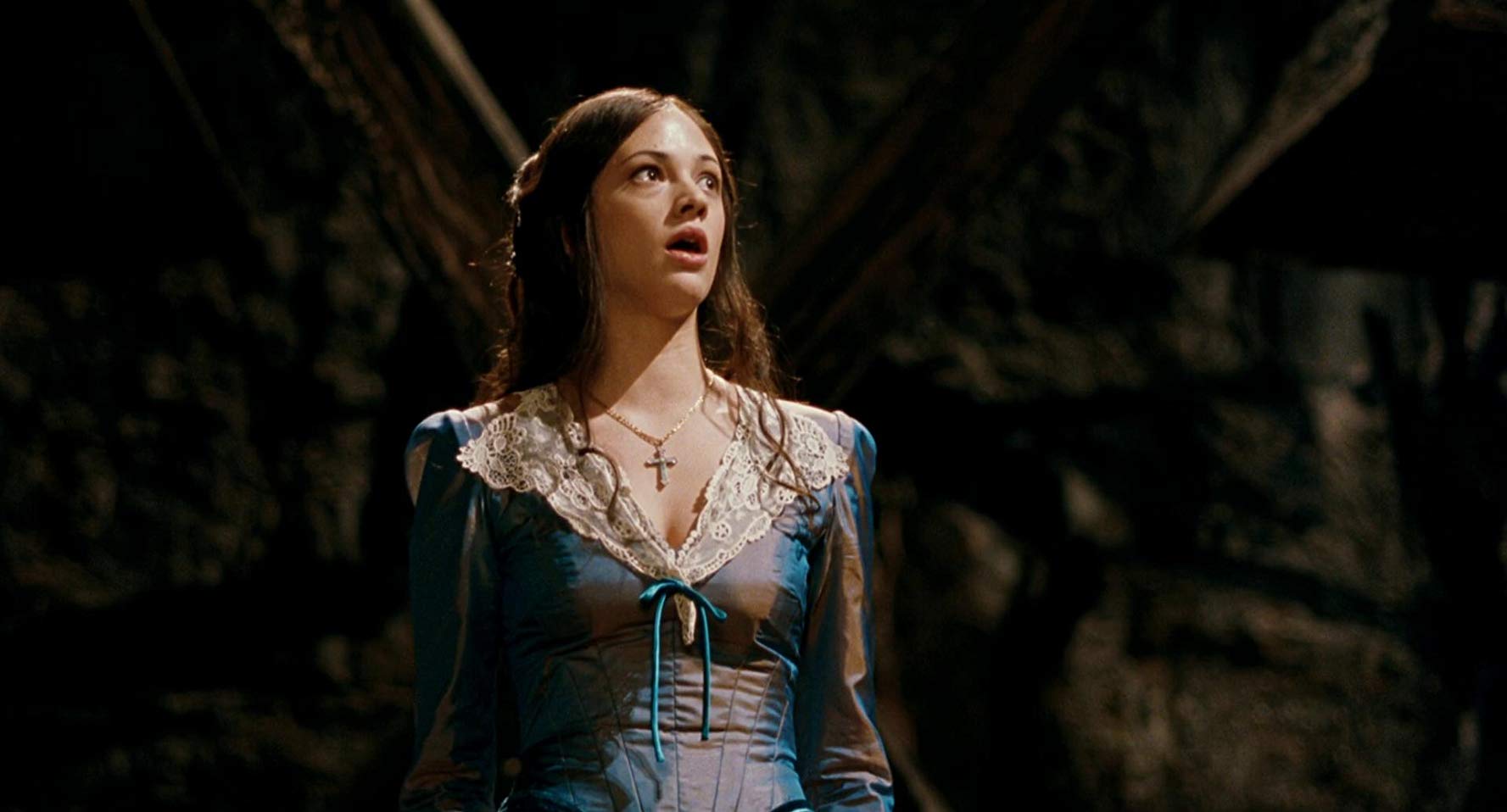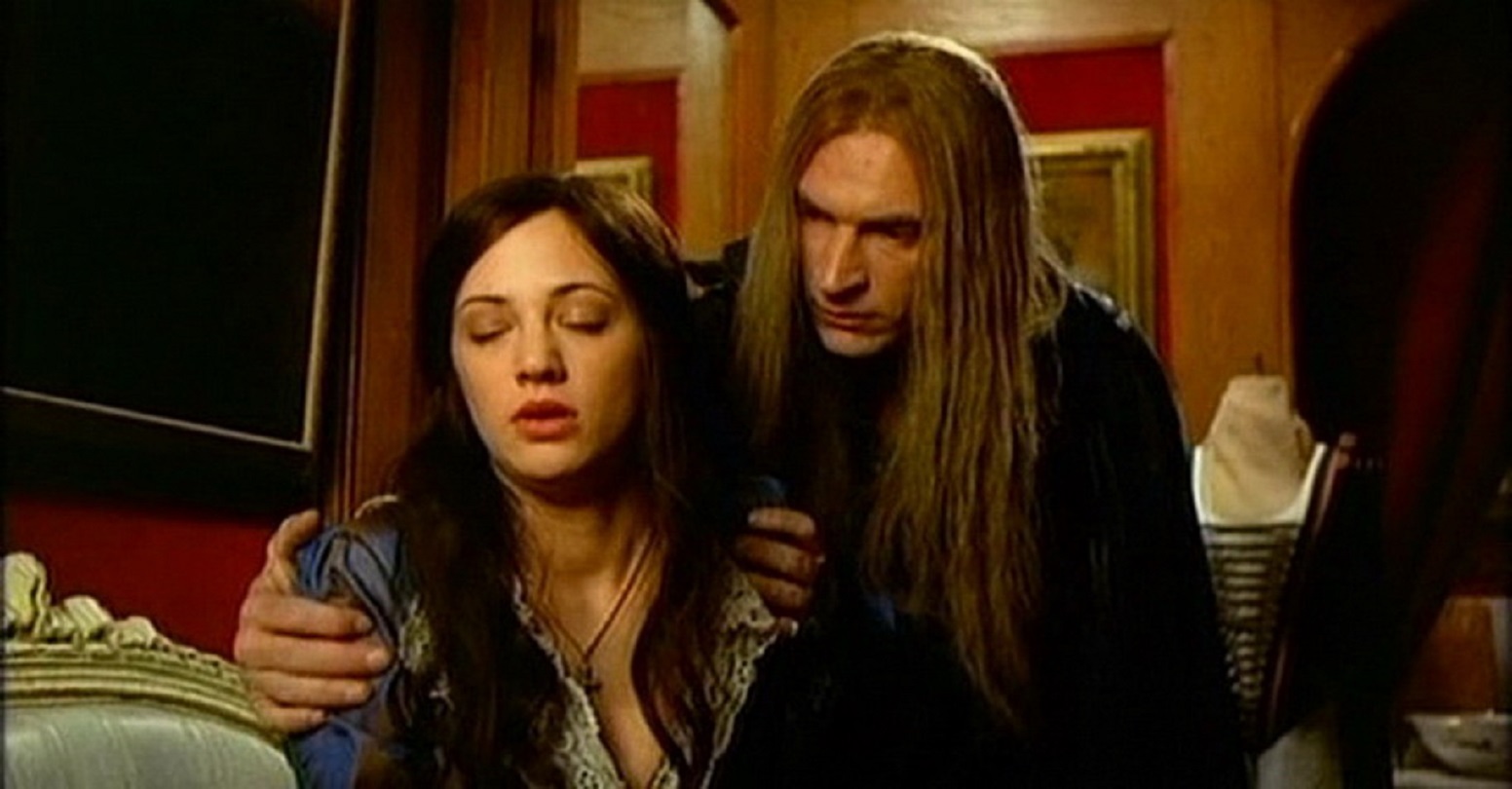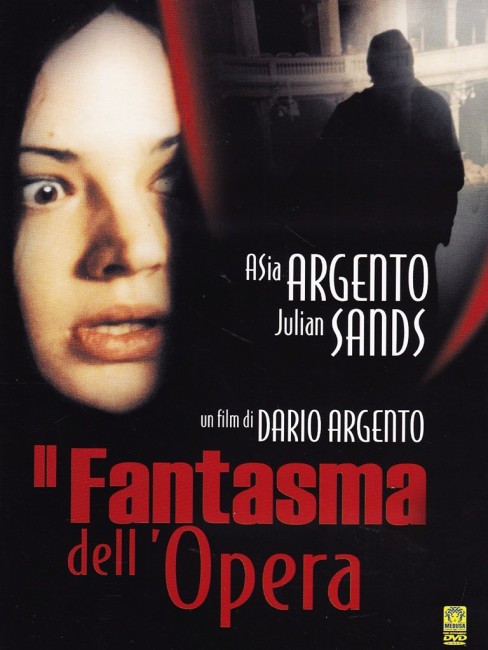(Il Fantasma dell’Opera)
Italy. 1998.
Crew
Director – Dario Argento, Screenplay – Dario Argento & Gerard Brach, Based on the Novel The Phantom of the Opera by Gaston Leroux, Producer – Giuseppe Colombo, Photography – Ronnie Taylor, Music – Ennio Morricone, Visual Effects – Sergio Stivaletti, Production Design – Antonello Geleng. Production Company – Medusa Film/Reteitalia/Cine 2000.
Cast
Asia Argento (Christine Daae), Julian Sands (The Phantom), Andrea Di Stefano (Baron Raoul de Chagny), Coralina Cataldi-Tassoni (Honorina), Nadia Rinaldi (Carlotta Altieri), Istvan Dubik (Ignasse), David D’Ingeo (Alfred), Kitty Keri (Paulette), Zoltan Barbas (Poligny), Aldo Massasso (Pourdieu), Leonardo Trevigio (Jerome de Changy), John Pedeferri (Dr Princard), Gianni Franco (Montluc)
Plot
1877. Christine Daae, an understudy at the Paris Opera House, finds that she is able to mentally communicate with a mysterious stranger. He is the rumoured Phantom who lives in the catacombs beneath the Opera House, communicating with the rats and killing those who stray into his domain. The Phantom now targets those who ignore his insistence that Christine be the star of the opera. At the same time, Christine finds herself romantically torn between the Phantom and the handsome Raoul de Chagny.
This was the seventh screen/tv adaptation of Gaston Leroux’s The Phantom of the Opera (1909). This version comes from no less than Italian horror director Dario Argento, famed for works like Suspiria (1977), Inferno (1980) and Opera/Terror at the Opera (1987). (See bottom of the page for Dario Argento’s other genre films).
One welcomes Dario Argento’s placing his hands on the story as the last few years have seen the The Phantom of the Opera story turned into something far too respectable, thanks to the Andrew Lloyd Webber Broadway musical, where the story is one now touted by the same people that hold West Side Story (1961) and My Fair Lady (1964) up as classics. The Lloyd Webber version has served to stuff and mount the story as a sweeping musical romance and its origins as a Gothic potboiler and a horror film were played down, if not entirely forgotten.
Dario Argento adapts the story with the help of Roman Polanski’s regular co-writing partner Gerard Brach. They make a noble attempt to wring new themes from an old story, although the dialogue occasionally comes out as pretentious: “I was abandoned at birth on the river of time and space,” The Phantom tells Christine in a romantic moment..

Argento plays up the horror aspect with severed torsos and graphic scenes of The Phantom mentally forcing a rat catcher to impale his hand inside one of his own traps where it is then gnawed at by rats, not to mention The Phantom’s biting out tongues and ripping off victim’s cheeks.
Argento certainly mounts a beautiful production. He emphasises the historical realism of the period, unlike any other version. The costumes have a sumptuousness – not the fantastical lavishness of other versions but more a lush realism. The historical detail is aided by Ronnie Taylor’s gorgeous photography, which blurs the colour tones until the film almost looks as though it is shot in sepia tone just like a Victorian photograph.
On the other hand, this is not the classic that filmmakers have failed to mount since the authoritative Lon Chaney version, The Phantom of the Opera (1925). The problem here is the film’s characterisation of The Phantom. This is an aspect that one thought Dario Argento would have had a field day with, his body of work demonstrating he would have more affinity for the mind of a tortured, deformed madman than most.
Instead, Argento’s Phantom is disappointingly ordinary – he is not masked or deformed, he is not even a composer. Cast as The Phantom, Julian Sands gives another of his wretched, cowering performances, which is totally wrong for the part. It makes the character too weak and wimpy where instead The Phantom should have shone with twisted genius and obsession. All this Phantom is is a man living in the caverns who likes rats. He even gets an opening origin that is filched from The Penguin’s origin in Batman Returns (1992).

Argento’s daughter Asia projects all the requisite innocent vulnerability and indecision as Christine, but in the end never leaves us moved to great romantic heights. Asia is a talented actress, as films like New Rose Hotel (1998) and B. Monkey (1999) have shown, but always seems constrained when working under her father.
Other versions of the story are:– Phantom of the Opera (1943) starring Claude Rains; The Phantom of the Opera (1962), the Hammer version starring Herbert Lom; Phantom of the Opera (1983), a tv movie starring Maximillian Schell; The Phantom of the Opera (1989), a slasher film starring Robert Englund; The Phantom of the Opera (1990), a tv mini-series starring Charles Dance; and The Phantom of the Opera (2004), the adaptation of the Andrew Lloyd Webber musical starring Gerard Butler. Other variations on the story are The Phantom of the Paradise (1974), a satirical version that sets the story to rock music; a pornographic version Phantom (1998); Angel of Music (2008) about a modern reporter conducting an investigation into the truth of the story; Phantom of the Theatre (2016), a Chinese version that conducts some radically different takes on the story; and modernisations like The Phantom of Hollywood (tv movie, 1974), The Phantom of the Ritz (1988), Phantom of the Mall: Eric’s Revenge (1989) and a Disney Channel children’s tv movie The Phantom of the Megaplex (2000), which had the Phantom haunting respectively a movie studio, a movie theatre, a mall and a cinema multiplex, as well as the low-budget The Phantom of the Opera (2014) where the Phantom’s spirit is disturbed by a reality tv crew.
Dario Argento’s other films are:– The Bird with the Crystal Plumage (1970), The Cat O’Nine Tails (1971), Four Flies on Grey Velvet (1971), Deep Red (1976), Suspiria (1977), Inferno (1980), Tenebrae/Unsane (1982), Phenomena/Creepers (1985), Opera/Terror at the Opera (1987), Two Evil Eyes (1990), Trauma (1993), The Stendhal Syndrome (1996), Sleepless (2001), The Card Player (2004), Mother of Tears: The Third Mother (2007), Giallo (2009), Dracula (2012) and Black Glasses (2022). Dario Argento has also written and produced Demons (1985), Demons 2 (1986), The Church (1989) and The Sect/The Devil’s Daughter (1991). Dario Argento’s World of Horror (1985), Dario Argento: An Eye for Horror (2001) and Dario Argento Panico (2023) are documentaries about Argento.
(Nominee for Best Cinematography at this site’s Best of 1998 Awards).
Trailer here

